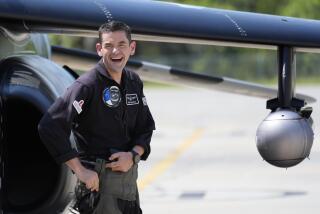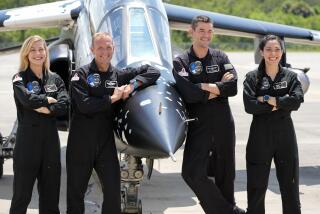Space Sailing: The Next Frontier?
- Share via
ITHACA, N.Y. — For 12 seconds on a blustery December morning in 1903, Wilbur and Orville Wright kept their hand-built flying machine aloft on the wind over the North Carolina coast, a seminal event that opened the age of air travel and changed the world.
Ann Druyan imagines how the pioneering brothers felt -- their determination, the sense of daring and, eventually, the unparalleled feeling of accomplishment.
She hopes to have a similar experience as part of an unprecedented international project -- known as Cosmos I -- to launch the first solar sail-powered vehicle in space. Some scientists believe that the technology is humankind’s best chance at making interstellar travel a reality.
“If we succeed, to me, that is an equivalent step of what happened at Kitty Hawk,” said Druyan, widow of visionary astronomer Carl Sagan. She is chief executive officer of Ithaca-based Cosmos Studios, the project’s principal backer.
Her efforts have suffered setbacks along the way, including the failure of a prototype last summer. But science is all about trial and error, she and her collaborators say.
Louis Friedman, director of the project, said the Wright brothers “spent 12 seconds in the air and went nowhere, but they proved powered flight was possible.”
“We want to prove that solar sailing is possible with this project,” said Friedman, executive director of the Planetary Society, co-founded in 1980 by Sagan, Friedman and Bruce Murray to advance solar-system exploration and the search for extraterrestrial life.
Space sailing uses reflected light pressure, said Friedman, who headed solar sailing research for NASA’s Jet Propulsion Laboratory in the 1970s.
When sunlight hits the surface of the sail, the energy of photons, or light particles, is transferred to the sail. As the light is reflected away, it gives the sail a slight push.
Existing chemical fuels have limitations. NASA’s fastest vehicles were Voyager I and II, which traveled about 38,000 mph. With solar sailing, the thrust is continuous and, although it starts slowly, the craft keeps increasing speed.
Friedman said theoretically a solar-sail craft could reach one-tenth the speed of light -- about 64 million mph -- by the time it reached Pluto, meaning a trip out of the solar system would take months instead of years. “There aren’t any other technologies we know of presently that will allow us to conquer interstellar distances in the same way,” he said.
In theory, anyway.
German astronomer and mathematician Johann Kepler in the early 1600s first observed that comet tails pointed away from the sun and theorized that there was a force emanating from the sun comparable to terrestrial winds.
Jules Verne dreamed in the late 19th century of great sailing ships that would ride the light. Scientists in the 1920s first realized that it was theoretically possible to use photons from the sun as a propulsion mechanism.
“There are important missions that are well-suited for solar sailing ... maybe not in this decade but not too far in the future,” said Chuck Gay, program executive of NASA’s New Millennium programs, which seek to validate new flight technologies.
He said there is “significant interest” in solar sailing at the National Aeronautics and Space Administration, calling the Cosmos I project “noble and inspiring.”
But the space agency is working on the technology rather than a flight mission. NASA’s work includes such efforts as designing new sail membranes so a craft could carry larger payloads without requiring enormous sails.
This year, NASA is spending about $20 million on new propulsion technologies, of which solar sailing gets a share. For 2003, the budget is being increased to $60 million. How much goes to solar sailing depends in part on the success of developments, Gay said.
Robert Zubrin of Pioneer Astronautics, a Lakewood, Colo.-based research and development company, is co-inventor of the magnetic sail, another promising non-chemical propulsion technology. He said a demonstration of solar sailing technology is “long overdue.”
He praised the Cosmos I project for getting technology “out of the box, out of the realm of discussion and graphs.”
“This has been a dream of scientists for 100 years and they are making it reality,” he said. “What they are doing is really the most critical step.”
The 220-pound Cosmos I was built by the Babakin Space Center in Russia and is expected to be launched this fall -- an exact launch date has not yet been set -- from a Russian nuclear submarine in the Barents Sea. It will be carried into space on a converted Soviet missile.
“Here was a way to turn one of the most awesome and terrible swords in any arsenal into a way of moving through the universe. For me, it was a way to demonstrate that I have learned what Carl Sagan was trying to teach,” Druyan said.
Druyan and Friedman are determined to see the project through to a successful completion despite such setbacks as last summer’s failure of a prototype to separate from the booster.
A successful project would represent a confluence of all Sagan held dear: a more peaceful world, a greater exploration of the cosmos and a clean energy technology as elegant as a sailing ship, Druyan said.
Another element of the project that thrills her is that Cosmos I will be visible with the naked eye the world over, even during the day.
“It will be as bright as the moon, although not as large. It will be like a new star in the sky. To me, it’s a star of hope,” she said.
Two-thirds of the project’s $4-million cost was paid by Druyan’s Cosmos Studios, a 2-year-old science-based media and entertainment venture that has reissued Sagan’s landmark television series on DVD and home video. Cosmos Studios also supports original scientific research and funded the expedition that led to the discovery in the Sahara of the second largest dinosaur ever found, the 60-ton Paralititan stromeri.
The remainder of the funding came from A&E; Television, which has a deal with Cosmos Studios for 12 two-hour science documentaries, including one on the solar-sailing project, and from Progressive Insurance chairman Peter Lewis, who says he is fascinated by space and intrigued by anything tried for the first time.
The project’s ability to succeed on such a small budget has been a target for skeptics.
It’s a point of pride for Druyan and Friedman, validating, they say, what the Wright brothers proved in their bicycle workshop: that discovery and scientific enterprise are not the venues of big-budgeted governments, but of anyone with daring and imagination.






